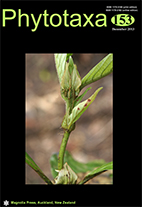Abstract
A marine species of Cocconeis (Bacillariophyta) from coral reef lagoon of Tahiti Island (Society Archipelago, South Pacific) was identified as Cocconeis pinnata W. Gregory ex Greville. Neither drawings nor micrographs of the raphe valve (RV) of C. pinnata are available in the literature. The examination of Gregory's type material (several slides annotated 'Arran 57' from Greville's collection housed in BM, British Museum, London, U.K.) allowed us to complete and emend the C. pinnata description. Lectotypification of C. pinnata is proposed. Since the raw material used by Gregory was not found, no scanning electron microscope (SEM) observation of type material can be provided. Except for Hustedt (1933) and a few later reports, all descriptions and illustrations agree with the original description. LM and SEM observations demonstrate that the sternum valve (SV) stria arrangement of specimens from Tahiti match those of the type. The description of the RV by Grunow in Van Heurck (1880) refers to a stria pattern very similar to that of C. pseudomarginata W. Gregory. The RV of C. pinnata, as revealed in LM and SEM, has a dense striation and no internal marginal rim. Both valves of C. pinnata have areolae with remarkable arborescent volae, which is a new feature for Cocconeis. Cocconeis pinnata is cosmopolitan, from cold-temperate to tropical areas. Several taxa have been formerly assigned to C. pinnata, though they are probably varieties of C. costata.

